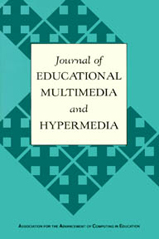Incidental learning and perceived disorientation in a web-based environment: Internal and external factors
In a four-factor MANOVA design, this exploratory study experimentally investigated the influence of navigation mode (linear, nonlinear), distracting links (presence, absence), sensation seeking tendency (high, low), and spatial-synthetic ability (high, low) on perceived disorientation and incidental learning (accuracy of main point, example generation) in web navigation. Seventy-five participants completed a search task to find the location of five sentences within a nine-page web-based passage. Regarding disorientation, a moderately large effect size indicated that those in the linear navigation mode were more disorientated than those in nonlinear navigation mode. Contrary to predictions, there were no effects on disorientation for spatial-synthetic ability and sensation seeking tendency. Regarding incidental learning, example generation was facilitated by sensation seeking tendency and the absence of distracting links; main point score was facilitated by spatial-synthetic ability. Further, a moderately large effect size indicated the role of the nonlinear navigation mode in facilitating higher main point and example generation scores. Disorientation was negatively correlated with both example generation and main point score.

